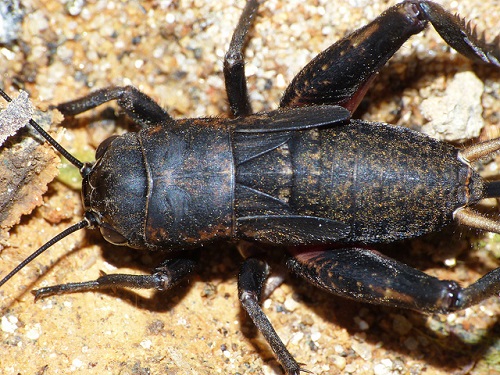Difference Between Black and Brown Crickets

Black Cricket
Black vs. Brown Crickets
Black and brown crickets are variants of the common cricket of the Gryllidae family. The Gryllidae family belongs to the Orthoptera order and the Gryllinae subfamily.
As both species and a part of the family, the two are closely related to the grasshopper and katydids. As crickets, they are scavengers and are classified as omnivorous. For their diet, crickets eat everything and anything. This means their main food is dead or dying organisms in their environment; it could be a dead plant or dead insects. An alternative means of food includes “bug grub,” a mixture of food and supplements or fruits and vegetables.
Crickets are famous for their chirping sounds. These sounds are performed only by the male crickets by rubbing their two front wings together. Their distinct anatomy includes a flat body, large and muscular rear legs, powerful jaws for biting, long antennae (called feelers), and small, leathery front wings.
Crickets with black or brown colorings are classified as house and field crickets, respectively. This means the brown crickets are usually found inside dwellings, while black crickets are generally encountered in outside surroundings.
Black and brown crickets differ in many ways. The most obvious distinction is the color of their bodies. Black crickets (with the scientific name Acheta assimilis) are considered to be meatier and larger. Their shell is also harder to bite for an animal, and they move slowly but are more aggressive than their brown counterparts. Black crickets are noted to stay on the ground most of the time. Additionally, they have spindlier legs.

Difference Between Black and Brown Crickets-1
On the other hand, brown crickets (known as Acheta domesticus) have a softer shell – or exoskeleton, and jump more frequently compared to black crickets. They are also slimmer and more compact than their black counterparts. Moreover, brown crickets can be bought in bulk as pet food or domestically bred for the same purpose.
In terms of temperament, brown crickets are more docile, while black crickets are more aggressive and tend to bite. Black crickets also tend to be noisier and eat more compared to their brown counterparts.
Both black and brown crickets are ideal as pets and as food for other animals. As pets, black and brown crickets are fairly low-maintenance but highly popular. Their popularity stems from the chirping noises they make. Maintaining a black or brown cricket requires an enclosure with proper ventilation and simple foods. Keeping the cricket warm is also an important aspect; crickets don’t usually survive past the winter season.
Many varieties of crickets are popular foods for other animals like reptiles (frogs, lizards, iguanas, tortoises, salamanders) and spiders. Brown and black crickets are often dusted or sprinkled with a supplement powder before being fed to the pet. This process is called “gut loading.” However, the crickets should be free from insecticide contamination before the pet can eat them.
Summary:
1.Black crickets are commonly known as field crickets, while brown crickets are known as house crickets.
2.Black crickets are larger, more aggressive, and do not tend to jump around, while their brown counterparts are smaller, slimmer, more docile, and use their legs for jumping.
3.Despite their moniker as “silent” crickets, brown crickets also make the same noise as black crickets.
4.Black crickets have a tougher body, or exoskeleton compared to brown crickets, which are softer. This difference makes brown crickets a favorite food choice for pet owners.
5.Brown crickets are available at pet shops as pet food for various amphibian pets and can be bred domestically for this purpose.
- Differences Between Fraternity And Sorority - January 8, 2014
- Differences Between Lucite and Plastic - January 7, 2014
- Differences Between Oil and Butter - January 6, 2014
Search DifferenceBetween.net :
6 Comments
Leave a Response
References :
[0]https://www.flickr.com/photos/haquintero/8145015216
[1]https://commons.wikimedia.org/wiki/File:Brown_Cricket_(Acanthogryllus_fortipes)_(12025556774).jpg

1.Black crickets are commonly known as field crickets while brown crickets are known as house crickets.
Crickets with black or brown colorings are classified as house and field crickets respectively
Great article except this confusion…
I had to read that over a couple of times myself. Rather sloppy mistake.
The process of ‘gut loading’ is when you feed the crickets lots of nutritious veg/fruit.
The process of adding supplement powder to the cricket is simply called ‘dusting’.
You should NEVER feed an iguana crickets, they are strictly vegetarian.
Thank you. Was frustrating as a beardir owner to read that. The dusting is for calcium to helo facilitate vitamin D3 absorption in the caged reptile’s liver, for anyone wondering. Also, a German Giant beardie WILL enjoy a black cricket as much as he enjoys a hissing roach; their exoskeletons are similar in strength.
Black crickets bite? I’ve kept many as pets and if you trap them in a ventillated cup for a couple hours, they become docile and appear to enjoy being held.
I found it interesting. Witch ones are best for fishing?
. Depends what you are after. I know from personal experience that the tougher larger black crickets will yield $200 squawfish bounty, daily if u know where to go, can drift-fish & manage 6 poles + boat, from 5am-1pm(8 hours) daily. It also helps if you use a salmon egg brine to toughen up bait so as to endure sm.fish & catch bigger squawfish. I have friend that has bought 40’RV +20’trailer w/boat & gear(in less than 2 seasons!). Sometimes he knocks the poles into the water just trying to get to the pole to set the hook. He has done it so many times it doesn’t bother him anymore. This is averaging more than 200 fish per session. But he manages to keep $200 worth qualified fish!